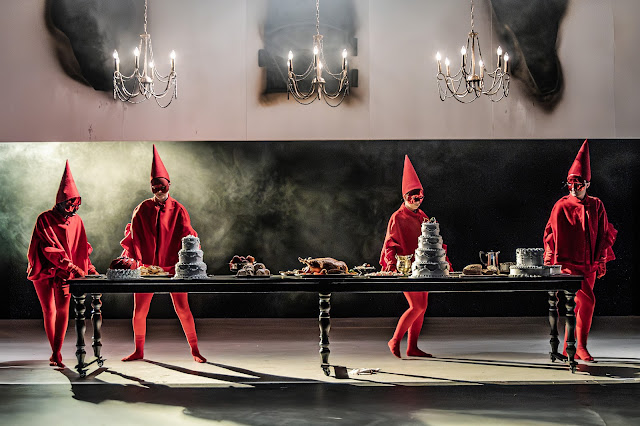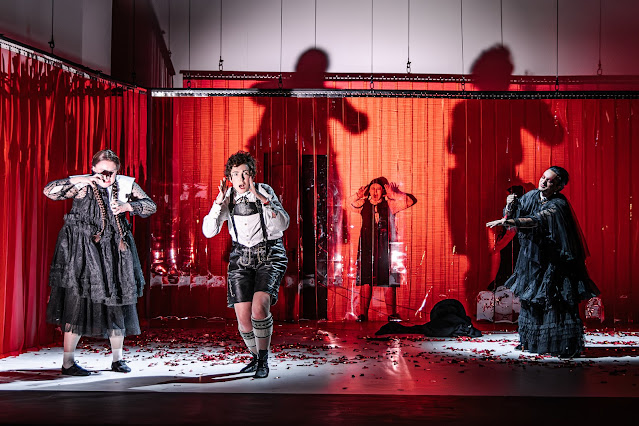 |
| Humperdinck: Hänsel und Gretel – Zahid Siddiqui (Witch) – Royal Academy Opera (Photo: Craig Fuller) |
Humperdinck: Hänsel und Gretel; Clover Kayne, Erin O’Rourke, Alex Bower-Brown, Zixin Tang, Zahid Siddiqui, director: Jack Furness, conductor: Johann Stuckenbruck, Royal Academy Opera; Susie Sainsbury Theatre, Royal Academy of Music
Reviewed 19 November 2024
A thought-provoking take on the traditional tale made all the more gripping by terrific performances all-round in an evening that was vivid theatrically and strong musically
Humperdinck’s Hänsel und Gretel is an opera ripe for mining for its inner meanings. A heart warning story that hides darker themes, with music that is full of singable tunes yet weaves this into a Wagnerian complexity. Influential productions by David Pountney (for ENO) and Richard Jones (for WNO) have mined different aspects of the stories psychological complexity. And for all the well-established urtext, directors bring a surprising freedom to the casting which can highlight this, doubling Mother and the Witch for instance, or having the Witch played by a tenor rather than a dramatic mezzo-soprano.
For Royal Academy Opera‘s Autumn production at the Royal Academy of Music‘s Susie Sainsbury Theatre, Jack Furness directed Humperdinck’s Hänsel und Gretel with Johann Stuckenbruck conducting the Royal Academy Sinfonia in a slightly reduced orchestration by Derek Clark. The opera was double cast and on 19 November 2024 we saw Clover Kayne as Hansel, Erin O’Rourke as Gretel, Alex Bower-Brown as Father, Zixin Tang as Mother, Zahid Siddiqui as the Witch, Charlotte Clapperton as the Sand Man and Abigail Sinclair as the Dew Man.
 |
| Humperdinck: Hänsel und Gretel – Hansel & Gretel (Clover Kayne & Erin O’Rourke) in the forest – Royal Academy Opera (Photo: Craig Fuller) |
Jack Furness and designer Alex Berry seem to have taken a thought-provoking view of the opera, fixing on the religious aspect to the music to set it in the context of a Puritan religious sect with everyone wearing sober black and white costumes, with bonnets for the women. During the overture we saw Gretel (Erin O’Rourke) alone in a small, sparse room, using a knife to cut paper chains of figures out of a book with a knife, lighting a candle almost as an offering, and a dark, hooded figure hints that the witch may not be quite what we expect.
Father and Mother (Alex Bower-Brown and Zixin Tang) were fierce and repressive, but what set the atmosphere was the way the world was populated by other silent figures, girls all dressed like Gretel. The wood was simply a larger version of the family’s house, a liminal space rather than an actual wood, and there were other figures who haunted it. Here, the iconography was striking but not obvious, and some of the figures seemed to need explanation. Gretel was attacked by these figures and bled. Significantly the colour palate of the production was the classic one of black and white with a touch of red, the red being associated with the witch.
The dream pantomime was a glorious feast for Hansel and Gretel with their parents, but the silent girls appeared and ate hungrily, almost scavenging, suggesting the sect kept its children without food, and the parents turned threatening, with Father examining Gretel to see if the bleeding was the result of sexual intercourse, suggesting the sort of sexual control exerted over the women.
 |
| Humperdinck: Hänsel und Gretel – Erin O’Rourke, Alex Bower-Brown, Zixin Tang – Royal Academy Opera (Photo: Craig Fuller) |
For the third act, the two children were in a different reality, their clothes far less repressive. There was a red door and the house, when it appeared, was simply red. The opening of this act saw Furness playfully hint at another Wagnerian theme, that of incest, though it seemed that Gretel was the instigator and Hansel far less interested.
The Witch was a superb turn by Zahid Siddiqui, using the fact of a male, tenor witch to create a fascinating yet threatening gender fluid creature who was very much their own creature, seductive yet predatory. They used a knife (the one from the prologue) to cut themselves to do magic, something Hansel and Gretel emulated, whilst the book, the paper figures and the burning from the prologue, all reoccurred. The end was less the redemption that Humperdinck intended, Father and Mother’s bringing back of the Evening Prayer was used as an oppressive tool, they brought Hansel back to heel within the confines of the sect. But having disposed of the Witch, Gretel put on her cloak and disappeared through the red door, presumably to become the next witch.
Hänsel und Gretel can have its longeurs, we spend two acts watching two badly behaved children and the most exciting character, the witch, only appears properly in the last act and doesn’t get anything like enough stage time. Clover Kayne and Erin O’Rourke gave superb performances, holding our attention and making us interested in these two. Kayne was surly, reluctant and rather reticent, but O’Rourke was definitely not a traditional Gretel, very self-possessed and with a big voice, this was a commanding performance and she and Kayne created their own world and drew us in. We cared about them, and if some of the dramaturgy and iconography was fuzzy or unclear, it didn’t matter because they made us care.
 |
| Humperdinck: Hänsel und Gretel – Dream Pantomime – Royal Academy Opera (Photo: Craig Fuller) |
Zahid Siddiqui gave a Drag Race-worthy performance as the witch. There was no element of rather fun pantomime, instead Siddiqui created a confident and threatening gender-fluid creature who was all their own. I have usually preferred the original casting of dramatic mezzo-soprano, though in the context of a conservatoire performance, having an extra male role was clearly a bonus and Siddiqui really ran with it. He was mesmerising whenever he was on stage and the witch’s demise was, to a certain extent, a sad event. You missed them.
Alex Bower-Brown and Zixin Tang gave strong performances as the parents, both keen on tough love, so that his pair of parents were fierce and demanding, the privation almost deliberate, for the better of their children’s souls. And the ending was disturbing indeed.
Charlotte Clapperton and Abigail Sinclair were musically charming as the Sand Man and the Dew Man, both in intriguing costumes and both rocking the productions distinctive iconography. The eleven chorus members (soprano and altos of both genders) were hard-working indeed, creating all manner of threatening and unnerving silent creatures who populated the stage.
 |
| Humperdinck: Hänsel und Gretel – Erin O’Rourke (Gretel), Clover Kayne (Hansel), Zahid Siddiqui (witch) – Royal Academy Opera (Photo: Craig Fuller) |
In the pit the Royal Academy Sinfonia with single woodwind (but two clarinets), two horns and single brass, gave a strong performance. Perhaps it took time to settle, musically, but under Johann Stuckenbruck confident direction the singers had chance to shine and the orchestral highlights were very much present.
Thanks to a strong cast, Furness’ intriguing take on the story was far more than a thought-provoking experiment, and the performances and strong ensemble meant that we were gripped from beginning to end.
The blog is free, but I’d be delighted if you were to show your appreciation by buying me a coffee.
Elsewhere on this blog
- Au cimetièrère de Montmartre: Julien Van Mellaerts & Alphonse Cemin in an imaginative trawl thro’ the denizens of a Paris cemetery – concert review
- Letter from Florida: New World Symphony Veterans’ Day Concert, A World War II Journey with Lidiya Yankovskaya & Emily Magee – concert review
- Glorious performances from Rhian Lois and Thomas Atkins lift ENO’s new production of Donizetti’s The Elixir of Love – opera review
- Life enhancing: the Orchestra of the Age of Enlightenment in Bach’s Brandenburg Concertos – concert review
- By some strange piece of magic, it works: Dancing Queen from Asya Fateyeva & Lautten Compagney Berlin mixes Rameau with the songs of ABBA – record review
- Colour, movement and tradition: Juan Diego Florez in Offenbach’s The Tales of Hoffmann at Covent Garden – opera review
- Powerful intensity, youthful vigour: Benjamin Hulett & Helen Charlston in Handel’s Jephtha at in Wimbledon – concert review
- Much more than a guilty pleasure: the songs of Reynaldo Hahn at the London Song Festival – concert review
- The sound of wind, sunlight or water: pianist Anna Tsybuleva on her new recording of Debussy’s Préludes on Signum Classics – interview
- A bright beginning: Three Sonatas reveals the distinctive voice of young composer Sam Rudd-Jones in chamber music that intrigues – record review
- Home








